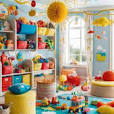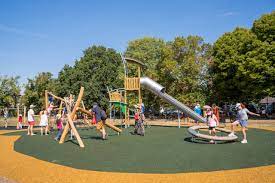Soft Play for Babies Under 1: Exploring Safe and Stimulating Environments
Soft Play for Babies Under 1: A Guide to Safe and Stimulating Fun
Soft play areas are not just for older children – they can also provide a safe and engaging environment for babies under 1 year old. These specially designed spaces offer a range of sensory experiences that can help stimulate your little one’s development.
The Benefits of Soft Play for Babies Under 1
Soft play areas are filled with colourful, textured, and interactive elements that can engage your baby’s senses and encourage exploration. Crawling through tunnels, playing with soft toys, and experiencing different textures can help develop their motor skills, coordination, and cognitive abilities.
Moreover, soft play provides a safe space for babies to move around freely without the risk of injury. The padded floors and walls ensure that even the most adventurous explorers can play without getting hurt.
Tips for Parents
- Always supervise your baby closely during soft play sessions.
- Encourage your baby to explore different areas of the soft play space to stimulate their curiosity.
- Bring along some of your baby’s favourite toys to make the experience even more enjoyable.
- Take breaks as needed to ensure that your baby doesn’t get overstimulated.
- Engage with your baby during playtime by talking to them, making eye contact, and encouraging their movements.
Safety Considerations
While soft play areas are designed to be safe for babies, it’s essential to keep a few safety tips in mind:
- Avoid overcrowded areas where there may be a risk of accidental collisions.
- Check that all equipment is in good condition before allowing your baby to play on it.
- Avoid placing very young babies on high structures or slides where they could fall.
- Ensure that older children are mindful of younger ones in the soft play area.
In conclusion, soft play can be a fantastic way for babies under 1 year old to explore, learn, and have fun in a safe environment. By following these tips and guidelines, you can ensure that your baby’s soft play experience is both enjoyable and beneficial for their development.
8 Benefits of Soft Play for Babies Under One: Safe Exploration and Development
- 1. Safe environment for babies to explore and play without the risk of injury.
- 2. Stimulates sensory development through colourful and textured play elements.
- 3. Encourages motor skills and coordination as babies crawl, climb, and interact with soft toys.
- 4. Provides a social setting where babies can observe and interact with other children their age.
- 5. Promotes cognitive development through engaging activities that spark curiosity.
- 6. Offers a fun and interactive way for parents to bond with their baby during playtime.
- 7. Helps babies build confidence as they navigate soft play structures independently.
- 8. Supports physical development by allowing babies to move freely in a padded environment.
Considerations for Soft Play with Infants: Germs, Overstimulation, Limited Activities, and Safety Concerns
- Risk of exposure to germs and bacteria due to shared play equipment.
- Potential for overstimulation if the environment is too noisy or crowded.
- Limited variety of activities tailored specifically for babies under 1 year old.
- Possibility of accidental bumps or falls, even in padded play areas.
1. Safe environment for babies to explore and play without the risk of injury.
Soft play areas provide a secure environment for babies under 1 to freely explore and play without the worry of potential injuries. The padded floors and soft structures ensure that little ones can crawl, toddle, and interact with sensory elements without the risk of bumps or falls. This safety feature allows parents and caregivers to relax knowing that their babies can engage in stimulating activities while being protected from harm, fostering a sense of confidence and independence in their early exploration journey.
2. Stimulates sensory development through colourful and textured play elements.
Soft play areas for babies under 1 offer a valuable opportunity to stimulate sensory development through a variety of colourful and textured play elements. These vibrant and tactile features engage infants’ senses, encouraging them to explore different shapes, colours, and textures. By interacting with these stimulating play elements, babies can enhance their sensory perception, develop fine motor skills, and foster cognitive growth in a safe and enjoyable environment.
3. Encourages motor skills and coordination as babies crawl, climb, and interact with soft toys.
Soft play for babies under 1 provides a wonderful opportunity to encourage the development of motor skills and coordination. As babies crawl, climb, and interact with soft toys in these specially designed areas, they are actively engaging their muscles and honing their physical abilities. The variety of movements involved in soft play activities helps babies strengthen their muscles, improve their balance, and enhance their coordination skills, setting a solid foundation for their physical development as they grow.
4. Provides a social setting where babies can observe and interact with other children their age.
Soft play areas for babies under 1 provide a valuable social setting where little ones can observe and interact with other children their age. This interaction allows babies to learn from each other, develop social skills, and begin to understand the concept of sharing and cooperation. By engaging with their peers in a safe and supervised environment, babies can build confidence, form early friendships, and lay the foundation for positive social interactions as they grow.
5. Promotes cognitive development through engaging activities that spark curiosity.
Soft play for babies under 1 promotes cognitive development through engaging activities that spark curiosity. By providing a variety of sensory experiences and interactive elements, soft play areas encourage babies to explore, discover, and learn. These stimulating activities help babies develop their cognitive skills as they engage with different textures, colours, and shapes, fostering a sense of wonder and curiosity that lays the foundation for future learning and development.
6. Offers a fun and interactive way for parents to bond with their baby during playtime.
Soft play for babies under 1 offers a fun and interactive way for parents to bond with their little ones during playtime. Engaging in soft play activities together not only strengthens the parent-child relationship but also creates special moments of joy and connection. Through playful interactions, such as exploring colourful sensory elements or crawling through tunnels, parents can actively participate in their baby’s development while building a strong emotional bond that lasts a lifetime.
7. Helps babies build confidence as they navigate soft play structures independently.
Soft play areas for babies under 1 provide a valuable opportunity for little ones to build confidence as they navigate the soft play structures independently. By exploring the padded tunnels, climbing small obstacles, and interacting with soft toys, babies can develop their sense of autonomy and self-assurance. As they conquer new challenges in a safe and supportive environment, babies gain a sense of achievement that boosts their self-esteem and encourages further exploration and discovery. This early experience of independence lays a strong foundation for their future development and learning.
8. Supports physical development by allowing babies to move freely in a padded environment.
Soft play areas for babies under 1 provide a wonderful opportunity to support their physical development by allowing them to move freely in a padded environment. The soft, cushioned floors and walls create a safe space where babies can crawl, roll, and explore without the risk of injury. This freedom of movement helps strengthen their muscles, improve coordination, and enhance their overall physical skills in a secure and nurturing setting.
Risk of exposure to germs and bacteria due to shared play equipment.
One significant concern regarding soft play areas for babies under 1 year old is the increased risk of exposure to germs and bacteria due to shared play equipment. With multiple children using the same toys, mats, and surfaces, it can be challenging to maintain proper hygiene standards. This heightened risk of germ transmission raises concerns about potential infections and illnesses that young babies with developing immune systems may be more susceptible to. Parents should remain vigilant about sanitizing their baby’s hands and toys after each play session to minimise the risk of exposure to harmful pathogens in these communal play spaces.
Potential for overstimulation if the environment is too noisy or crowded.
One significant con of soft play areas for babies under 1 year old is the potential for overstimulation if the environment becomes too noisy or crowded. Young babies are still developing their sensory processing abilities, and excessive noise or a crowded space can overwhelm them, leading to stress and discomfort. It is essential for parents and caregivers to be mindful of the sensory environment in soft play areas to ensure that their little ones have a positive and enjoyable experience without becoming overstimulated.
Limited variety of activities tailored specifically for babies under 1 year old.
One challenge of soft play areas for babies under 1 year old is the limited variety of activities specifically tailored to their developmental needs. While these spaces offer sensory stimulation and safe environments, the lack of age-appropriate activities can sometimes limit the engagement and learning opportunities for the youngest visitors. It’s important for parents and caregivers to seek out soft play areas that provide a range of activities designed specifically for babies under 1 to ensure that their little ones can fully benefit from their play experiences.
Possibility of accidental bumps or falls, even in padded play areas.
Soft play areas for babies under 1 present a potential con in the form of the possibility of accidental bumps or falls, even in padded play areas. While the soft padding is designed to minimize the risk of injury, young infants who are still developing their motor skills may inadvertently bump into objects or lose their balance. It is essential for parents and caregivers to closely supervise their babies during playtime to prevent any mishaps and ensure a safe and enjoyable experience in the soft play environment.


